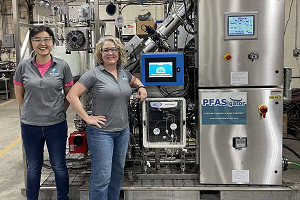Hot Off the Press
E-Factor Stories

Meng Wang, Ph.D., left, and Dennise Kay, Ph.D., developed the mobile, fully automated PFAS destruction unit, called the PFASigator™, that can be used alone or plugged directly into existing water treatment systems. (Photo courtesy of Enspired Solutions)
Water Treatment Technology Aims to Destroy PFAS On-site
Enspired Solutions, a woman-owned environmental remediation company, received an NIEHS Superfund Research Program (SRP) small business innovation research grant to develop a technology to destroy PFAS in water.
Superfund Research Program helps bring data science into the classroom
In summer 2024, the NIEHS-funded North Carolina State University SRP Center launched a year-long project to bring data science into middle and high schools across North Carolina.
Protein Plays Contradictory Roles in Preventing and Promoting Disease
A protein called NRF2, which controls a protective response against oxidative stress, may also promote disease if it is activated for extended periods of time, according to Donna Zhang, Ph.D., during a September 10 Distinguished Lecture at NIEHS. Zhang, a professor at the University of Florida, leads a research project at the University of Arizona SRP Center.
Exposure to mixtures of PFAS chemicals may pose a greater health risk than exposure to a single PFAS alone, according to SRP-funded researchers at the State University of New York at Buffalo. Results suggest that different PFAS compounds interact in ways that make a mixture more toxic.
Tap water quality in Puerto Rico showed partial recovery starting six months after Hurricane Maria, according to researchers partly funded by the Northeastern University SRP Center. The study provides the first long-term, island-wide assessment of changes in drinking water quality following the storm.
Extramural Paper of the Month: Microbe Commonly Found in the Environment can Destroy Specific PFAS
SRP-funded researchers at the University of California, Los Angeles identified a type of bacteria, called Acetobacterium, that can destroy specific PFAS. These microorganisms are found in wastewater environments and can potentially be used as a cost-effective and environmentally friendly approach to remediate sites contaminated with PFAS.
News Stories

Researchers walk the perimeter of the Louisville Public Library during the site visit. (Photo courtesy of Luz Huntington-Moskos)
Researchers Team Up with Louisville Community to Investigate Chemical Exposures
Concerns about volatile organic chemicals (VOCs) potentially leaking into a library in Louisville prompted action by SRP centers. Collaborators at the University of Kentucky and University of Louisville (UofL) came together with local researchers and community members to address the problem.
Research Briefs
Combining Plants and Sunlight to Break Down Hazardous Compounds
Researchers funded by SRP created a new material from a plant-based compound that uses sunlight to break down hazardous compounds, like PFAS. Susie Dai, Ph.D., who leads an SRP-funded individual research project at Texas A&M AgriLife Research led the study.
User-friendly Technology Detects NDMA in Water
A new technology, developed by researchers at the Massachusetts Institute of Technology SRP Center, can detect the contaminant N-nitrosodimethylamine (NDMA) in water. This breakthrough tool offers a quick way to monitor NDMA by triggering a visible color change when light interacts with the contaminated solution.
Passive Samplers Track PFAS, Show Contamination Reduction in Cape Fear River
Common low-cost samplers may be an effective technology for tracking PFAS levels in aquatic environments, according to an SRP-funded study. Erin Baker, Ph.D., a project leader at the Texas A&M University SRP Center and part of the analytical core at the North Carolina State University SRP Center, led the team.
Hot Publications
Check out our Hot Publications page to see brief summaries of papers that have been featured in the monthly e-Posted Notes newsletter!
to Top



